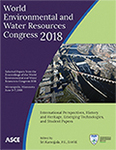World Environmental and Water Resources Congress 2018
Textile Dye Wastewater Biotreatment—A Project Empowering Female Leadership through International Exchange
Publication: World Environmental and Water Resources Congress 2018: International Perspectives, History and Heritage, Emerging Technologies, and Student Papers
ABSTRACT
International exchanges and sponsorships allow female scholars opportunities for broader engagement in the scientific community. In 2016, Noshaba Hassan Malik, a Ph.D. student at Quaid-i-Azam University in Islamabad, Pakistan, conducted research with Dr. Heidi L. Gough, faculty at the University of Washington. The exchange allowed both scholars to expand their knowledge base and to better understand differences between the two academic institutions. Particularly, because women tend to be less engaged in international scientific exchanges, this model serves as an example of the power of long-term exchange in improving female engagement in global water research. During the exchange, Dr. Gough and Ms. Malik worked together to characterize the biotreatment potential of newly isolated bacteria that were capable of degrading dyes found in textile wastewater. The approach of using of bacteria capable of decoloring dyes has been proposed for development of biologic treatment options for wastewater produced during textile dyeing. Specialized bacteria have been reported that decolor textile wastes. However, knowledge of the kinetics of decolorization is needed to develop and model a treatment approach. This study documented the ability of newly-isolated bacteria to degrade a mixture of three dyes (reactive red, blue, and yellow) in batch reactors, and established their kinetic rates of degradation; this data is presented in the main text. An over-arching goal of the project is to apply kinetics knowledge for development of larger-scale reactor systems that can be used in developing nations where currently available treatment is often not an economically viable option.
Get full access to this article
View all available purchase options and get full access to this chapter.
ACKNOWLEDGEMENTS
Funding was provided by the Amazon Catalyst Program at the University of Washington and through a scholarship from the Higher Education Council (HEC) of Pakistan (to NHM). We thank Elizabeth Guilford, Sterling Bath and Keenan Ferar, for their assistance with data collection. We thank Dr. Naeem Ali, Quaid-i-Azam University, for his contributions to NHM’s original work isolating the cultures used in this study.
REFERENCES
Ali, N, Hameed, A, Ahmed, S. (2009). “Physicochemical characterization and bioremediation perspective of textile effluent, dyes and metals by indigenous bacteria.” J Hazard Mater, 164, 322–328.
Axelsson, J, Nilsson, U, Terrazas, E, Alvarez Aliaga, T, Welander, U. (2006). “Decolorization of the textile dyes Reactive Red 2 and Reactive Blue 4 using Bjerkanderasp. strain BOL 13 in a continuous rotating biological contactor reactor.” Enzyme Microb Technol, 39, 32–37.
Bhattacharya, A, Goyal, N, Gupta, A. (2017). “Degradation of azo dye methyl red by alkaliphilic, halotolerant Nesterenkonia lacusekhoensisEMLA3: application in alkaline and salt-rich dyeing effluent treatment.” Extremophiles, 21, 479–490.
Deive, FJ, Domínguez, A, Barrio, T, Moscoso, F, Morán, P, Longo, MA, Sanromán, MA. (2010). “Decolorization of dye Reactive Black 5 by newly isolated thermophilic microorganisms from geothermal sites in Galicia (Spain).” J Hazard Mater, 182, 735–742.
Jonstrup, M, Kumar, N, Murto, M, Mattiasson, B. (2011). “Sequential anaerobic-aerobic treatment of azo dyes: Decolourisation and amine degradability.” Desalination, 280, 339–346.
Karamba, KI, Ahmad, SA, Zulkharnain, A, Yasid, NA, Ibrahim, S, Shukor, MY. (2018). “Batch growth kinetic studies of locally isolated cyanide-degrading Serratia marcescensstrain AQ07.” Biotech, 8, 11.
Khalid, A, Arshad, M, Crowley, DE. (2008). “Decolorization of azo dyes by Shewanellasp. under saline conditions.” Appl Microbiol Biotechnol, 79, 1053–1059.
Lide, DR, editor-in-chief. (1996). CRC Handbook of Chemistry and Physics, 77th Edition. Appendix A: Mathematical Tables. CRC Press, Inc. Boca Raton, Florida.
Rawat, D, Mishra, V, Sharma, RS. (2016). “Detoxification of azo dyes in the context of environmental processes.” Chemosphere, 155, 591–605.
Robinson, T, Mcmullan, G, Marchant, R, Nigam, P. (2001). “Remediation of dyes in textile effluent: a critical review on current treatment technologies with a proposed alternative.” Bioresour Technol, 77, 247–255.
Saratale, RG, Saratale, GD, Chang, JS, Govindwar, SP. (2011). “Bacterial decolorization and degradation of azo dyes: A review.” J Taiwan Inst Chem Eng, 42, 138–157.
Solís, M, Solís, A, Pérez, HI, Manjarrez, N, Flores, M. (2012). “Microbial decolouration of azo dyes: A review.” Process Biochem, 47, 1723–1748.
Spagni, A, Grilli, S, Casu, S, Mattioli, D. (2010). “Treatment of a simulated textile wastewater containing the azo-dye reactive orange 16 in an anaerobic-biofilm anoxic-aerobic membrane bioreactor.” Int Biodeterior Biodegrad, 64, 676–681.
Information & Authors
Information
Published In
World Environmental and Water Resources Congress 2018: International Perspectives, History and Heritage, Emerging Technologies, and Student Papers
Pages: 238 - 249
Editor: Sri Kamojjala, Las Vegas Valley Water District
ISBN (Online): 978-0-7844-8139-4
Copyright
© 2018 American Society of Civil Engineers.
History
Published online: May 31, 2018
Authors
Metrics & Citations
Metrics
Citations
Download citation
If you have the appropriate software installed, you can download article citation data to the citation manager of your choice. Simply select your manager software from the list below and click Download.
